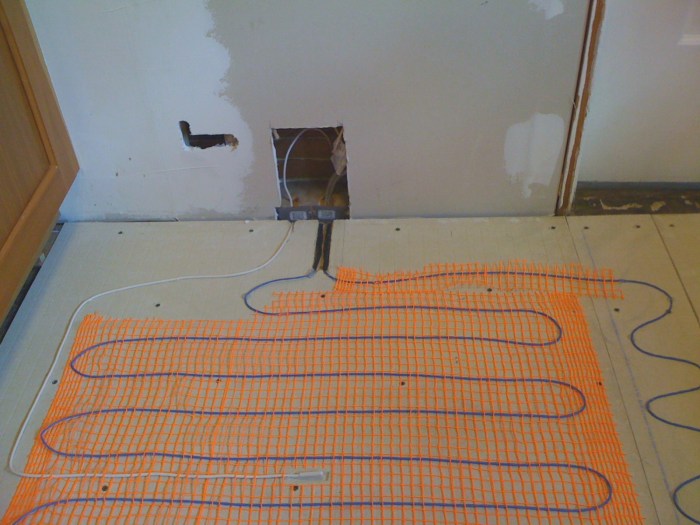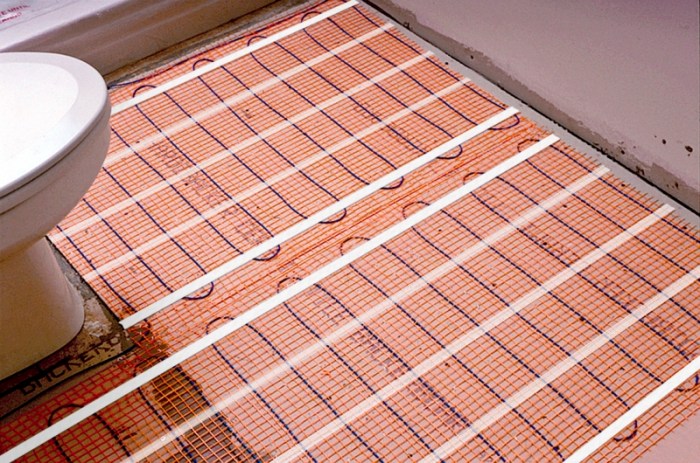Transform your small bathroom into a cozy haven with the installation of heated floors. Not only do heated floors provide unparalleled comfort, but they also enhance the overall ambiance of your space. From luxurious marble tiles to sleek vinyl planks, there’s a wide range of flooring options available to complement any bathroom design.
Installing heated floors in a small bathroom is a relatively straightforward process that can be completed with proper planning and preparation. Whether you’re tackling the project yourself or hiring a professional, this guide will provide you with the essential information you need to create a warm and inviting bathroom space.
Introduction
Installing heated floors in your small bathroom can be a worthwhile investment, providing both comfort and energy efficiency.
There are several types of heated floors available, including electric, hydronic, and radiant floor heating. Electric heated floors are the most common and easiest to install, while hydronic and radiant floor heating require more complex installation processes.
Installation Process
The installation process for heated floors typically involves the following steps:
- Preparing the subfloor by leveling and smoothing it.
- Installing the heating element, which can be electric cables, hydronic tubing, or radiant panels.
- Covering the heating element with a layer of self-leveling compound or mortar.
- Installing the flooring material, such as tile, stone, or hardwood.
Planning and Preparation
Before installing heated floors in your bathroom, it is crucial to plan and prepare thoroughly. This will ensure a successful and efficient installation process.
Determining Size and Shape
The size and shape of your bathroom will determine the amount of heated flooring material you need and the layout of the system. Measure the length and width of the bathroom, including any nooks or alcoves, to calculate the square footage.
Choosing the Right Type of Heated Floor
There are various types of heated floors available, including electric, hydronic, and radiant panel systems. Consider factors such as the bathroom’s size, budget, and energy efficiency goals when selecting the most suitable option.
Gathering Tools and Materials
Gather all the necessary tools and materials before starting the installation process. This may include a heated flooring system, insulation, tile adhesive, grout, spacers, a trowel, and a level.
3. Installation
The installation process for heated floors involves preparing the subfloor, installing the heating element, installing the flooring, and testing the heated floor. Here’s a breakdown of each step:
Subfloor Preparation
Before installing the heating element, the subfloor must be properly prepared. This includes ensuring that the subfloor is level, smooth, and free of any debris or irregularities. Any unevenness or imperfections in the subfloor can affect the performance and lifespan of the heated floor system.
4. Maintenance and Troubleshooting
Maintaining a heated floor is relatively simple and requires minimal effort. Here are some tips to keep your heated floor in optimal condition:
- Regularly clean the floor using a mild detergent and a soft cloth.
- Avoid using abrasive cleaners or harsh chemicals, as these can damage the heating element.
- Keep the floor free of debris and spills, as these can interfere with the heat distribution.
- Inspect the floor regularly for any signs of damage, such as cracks or loose wires.
Common Problems and Troubleshooting
Heated floors are generally reliable and durable, but occasionally, problems can occur. Here are some common issues and their troubleshooting steps:
- Uneven heating: This can be caused by improper installation or a faulty heating element. Check the connections and ensure the heating element is evenly distributed throughout the floor.
- Floor not heating up: This can be caused by a tripped circuit breaker or a faulty thermostat. Reset the circuit breaker and check the thermostat settings.
- Flickering or intermittent heating: This can be caused by a loose connection or a faulty heating element. Inspect the connections and replace the heating element if necessary.
- Burning smell: This can be caused by a faulty heating element or a damaged wire. Turn off the power and contact a qualified electrician immediately.
Last Point
With careful planning and execution, installing heated floors in your small bathroom can elevate your daily routine to a new level of comfort and luxury. Embrace the warmth and style that heated floors bring, and enjoy the cozy ambiance they create for years to come.



